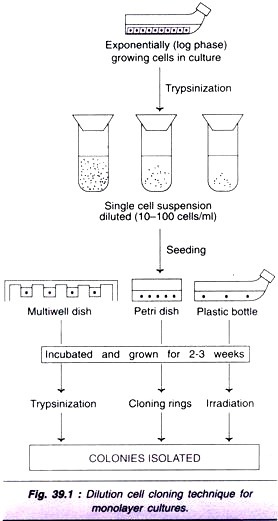ADVERTISEMENTS:
In this article we will discuss about the tests for estimation of ascorbic acid in plants.
Principle:
Ascorbic acid oxidase acts on the substrate ascorbic acid to form dehydro-ascorbic acid. The residual ascorbic acid content is determined by titration using a dye solution (Dichlorophenol indophenol, an oxidation-reduction dye):
Requirements:
(a) Reagents:
ADVERTISEMENTS:
1. Dye solution:
ADVERTISEMENTS:
15 mgm of 2-6 dichlorophenol indophenol is dissolved in 50 ml of dist. water. 20 gm. of NaHCO3 is added and shaken vigorously. Finally, the solution is diluted to 100 ml and filtered and kept in a coloured glass bottle.
2. Tri-choloro-acetic acid — 10%.
ADVERTISEMENTS:
3. Ascorbic acid soln. — 50 mgm of acid is dissolved in 100 ml of dist. water.
(b) Glass-wares:
Conical flask, Beaker, Pipette, Burette etc.
(c) Preparation of enzyme extract:
15 gm. germinated seeds of rice is extracted with dist, water for getting enzymes by the usual crushing method. Then the extract is made up to 100 ml adding distilled water.
Test Procedure:
1. In a conical flask, 2 ml substrate (ascorbic acid), 2 ml enzyme extract and 3 ml distilled water is taken and the mixture is incubated at 28 ± 1°C for 20 mins.
2. Then enzymatic reaction is stopped by the addition of 5 ml of 10% trichloroacetic acid (TCA) solution.
3. Now the mixture is ready for titration against dye solution.
ADVERTISEMENTS:
4. The set is replicated at least thrice.
5. Control sets are also prepared for titration, which contain only 2 ml substrate, 5 ml distilled water and 5 ml 10% TCA solution.
6. When the reaction mixture is titrated against the dye soln., the colour of the dye is rapidly discharged. The readings are taken when a faint blue colour persists for at least 15 sec.
7. From the difference of readings between the control sets and enzyme reactions sets, the enzyme activity is calculated and expressed as ascorbic acid decomposed/gm. of tissue/min.

